What is Anchor Text?
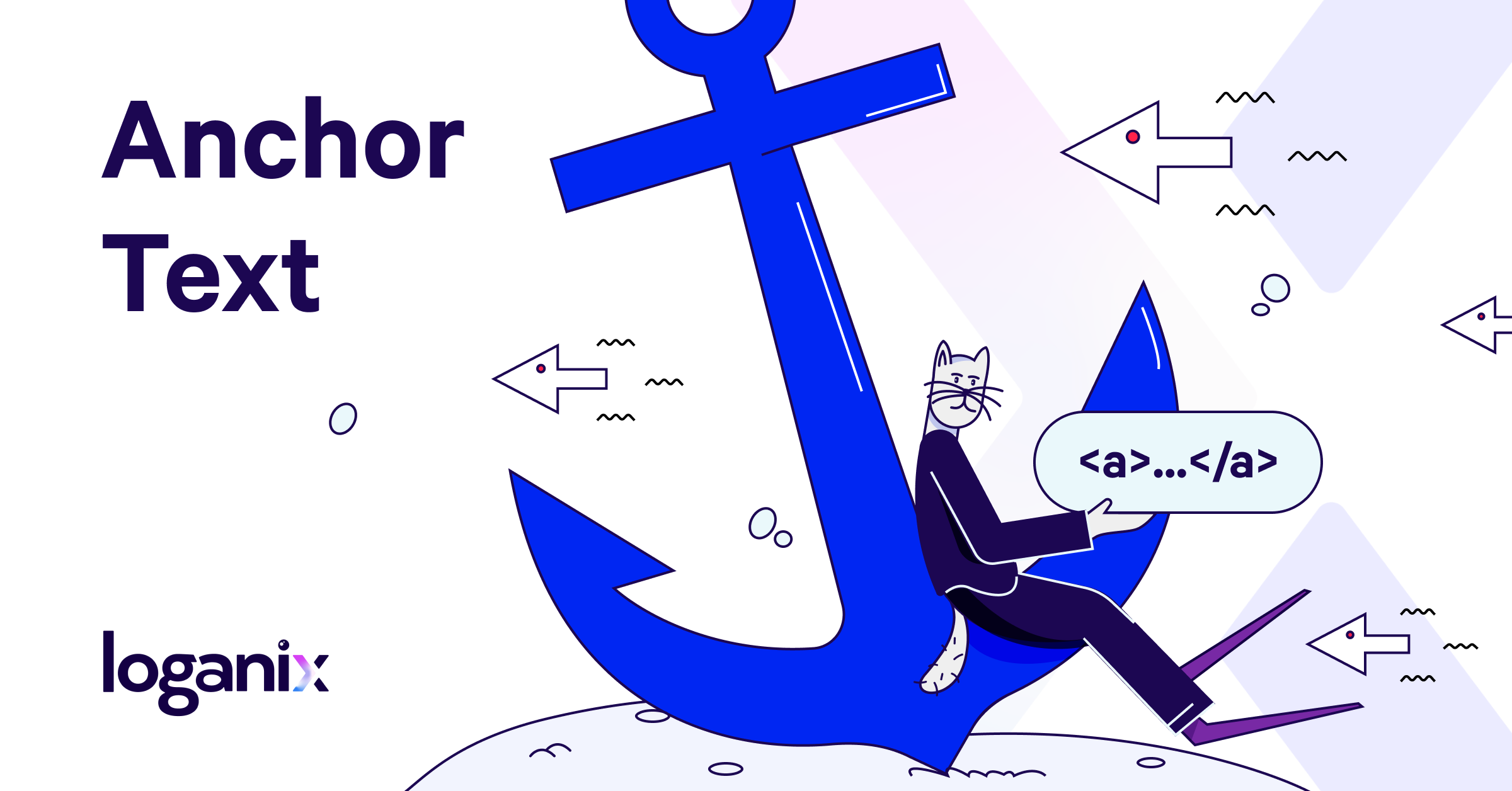
Hand off the toughest tasks in SEO, PPC, and content without compromising quality
Explore ServicesAs simple as adding a hyperlink to a web page may seem, setting the link’s anchor text with unsuitable copy can have a serious impact on your site’s ability to rank.
Get it right though, and your off-page and on-page SEO is sure to skyrocket your site to the top of the SERPs.
To be sure you’re building your anchor text profile out with the right blend of variation, relevance, and natural appearance, here we cover:
- the basics of what anchor text is,
- why anchor text is important,
- the different types of anchor text,
- and we’ll also jump into anchor text best practices.
What is Anchor Text?
Anchor text is the visible, clickable text in a hyperlink. And although its appearance will vary depending on the styling used a website uses, typically, anchor text is the blue, underlined text you see on a web page when you mouse over a link.
When a user clicks on anchor text, they are taken to a predetermined destination URL – whether that be a jump link within the same web page, a link to another web page on the same website, or a link leading to a web page on an external website.
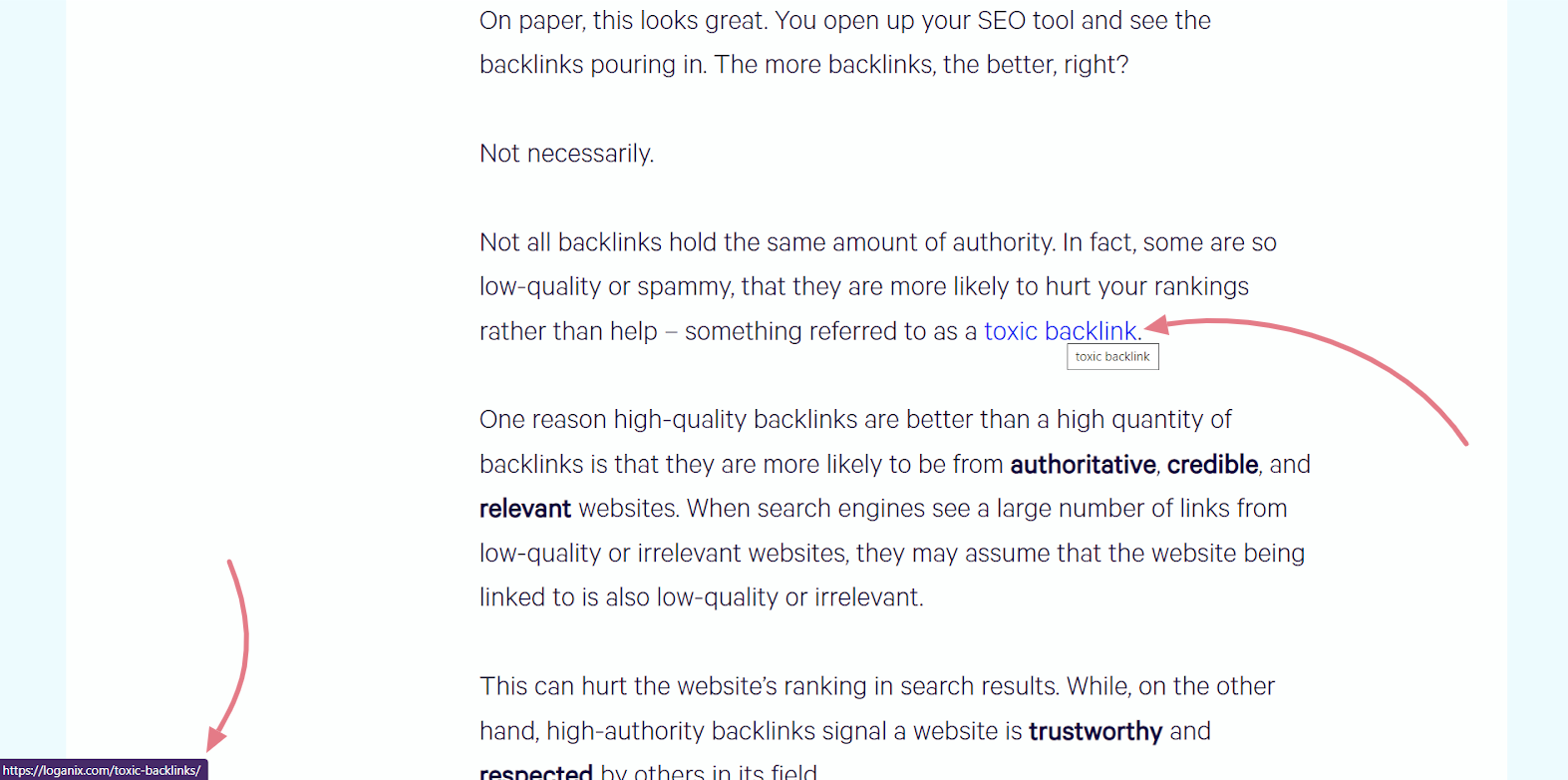
Highlighted by the blue text, here you can see an example of an anchor text we’ve added to our blog.
The text we’ve chosen to use, “toxic backlink”, gives the reader a clear idea of what they’ll find if the hyperlink is clicked. Additionally, indicated by the smaller arrow, when the anchor text is hovered over, you can see the destination URL pop up in the bottom part of the left-hand side of the screen.
Why is anchor text important?
The main purpose of anchor text is to provide context as to where a hyperlink will lead. Context not just to the user but, perhaps more importantly, to Google.
Google uses backlinks and internal links to index the internet through the use of web crawlers. Known as Googlebots, these crawlers examine web pages and follow the links they find to discover unindexed pages.
Why is this important?
Well, when someone searches for something on Google, the search engine sieves through its database of previously indexed web pages to find the best match for their search query, subsequently returning the results that are most relevant to the user.
This is why anchor text is so important.
As the Googlebots do their work, they use external anchor text to discern what the linked to page is all about. Additionally, the anchor text used for a hyperlink gives Google an idea of which target keyword the linked to content should rank for.
As an example, let’s say your site resides in the SaaS niche and you’ve written a piece of content all about “big data vs AI”.
By using this phrase as the anchor text on other pages within your website, you’re signaling to Google that the linked to page is most likely about, well, big data and artificial intelligence.
Couple anchor text like this with on-page keywords, the use of the target keyword in your headings and subheadings, the addition of the keyword in your meta description, and Google will soon understand what topic you’ve covered within the post.
Google will then index this post and when a search engine user searches a query relevant to the topic you’ve covered within this page, it may just recommend it to users on the search engine results page (SERPs).
We’d be remiss here if we didn’t also mention that anchor text has the potential to hurt your search engine rankings.
Anchor text used incorrectly or in a manipulative way can be viewed by Google’s algorithm as deceptive.
Targeted by Google’s infamous Penguin algorithm, if a website uses anchor text that:
- lacks relevance to the content it’s linked to (referred to as unnatural inbound links),
- excessively uses exact match anchor text,
- uses anchor text in a spammy and unnatural manner,
- or overuses generic anchor text,
Google may penalize the website for trying to intentionally or unintentionally manipulate search results.
7 Types of Anchor Text (+ Examples)
To help you nail the correct use of anchor text and avoid penalization from Google’s Penguin update, here are the different types of anchor text.
- Exact match
- Phrase match
- Partial match
- Branded
- Naked URL
- Random
- Image links
Let’s take a look at these different types of anchor texts in more detai (along with some examples of each:
1. Exact match
Exact match anchor text is a type of anchor text that matches the exact keyword or phrase you are targeting within a post.
Example: “big data vs AI”.
2. Phrase match
Similar to exact match anchor text, phrase match anchor text contains the match keyword but also consists of other words.
Example: “big data vs AI (artificial intelligence)”.
3. Partial match
Partial match anchor text consists of all the words of a target keyword, just not as an exact match. Perhaps instead, an alternative keyword is the target here.
Example: “what’s the difference: big data vs AI”
4. Branded
Branded anchor text is simply a business’s brand name being the subject of a hyperlink.
Example: “Loganix”
5. Naked URL
A naked link anchor text is a URL in its raw form – just as you’d see it in your browser’s address bar.
Example: “https://loganix.com/toxic-backlinks”.
6. Random
Random anchor text is the use of a generic phrase or word.
Example: “click here” or “check this out”.
7. Image links
Image anchors are the alt text added to images.
Example: <a href=”“https://loganix.com/toxic-backlinks”><img src= “/toxic-backlink.jpg” alt= “Toxic Backlinks”/></a>
6 Anchor Text Best Practices
To be sure you’re nailing the use of anchor text, here are some best practices to integrate into your content marketing flow.
1. Be Versatile in Your Approach to Anchor Text
As concluded by Ahrefs in their case study of nearly 390,000 web pages, the use of all the different kinds of anchor text is your best bet of pleasing the SERP gods.
The results?
Ahrefs recommends that the best approach to the use of anchor text is to keep your anchor text profile as versatile as possible.
By using a variety of anchor text, such as keyword-rich anchors, branded anchors, and partial match anchors, you can help improve the relevancy of your website’s content to search engine queries. This, in turn, can result in higher web traffic and improved ROI for your online business.
As an example of this, let’s revisit our SaaS topic: big data vs AI.
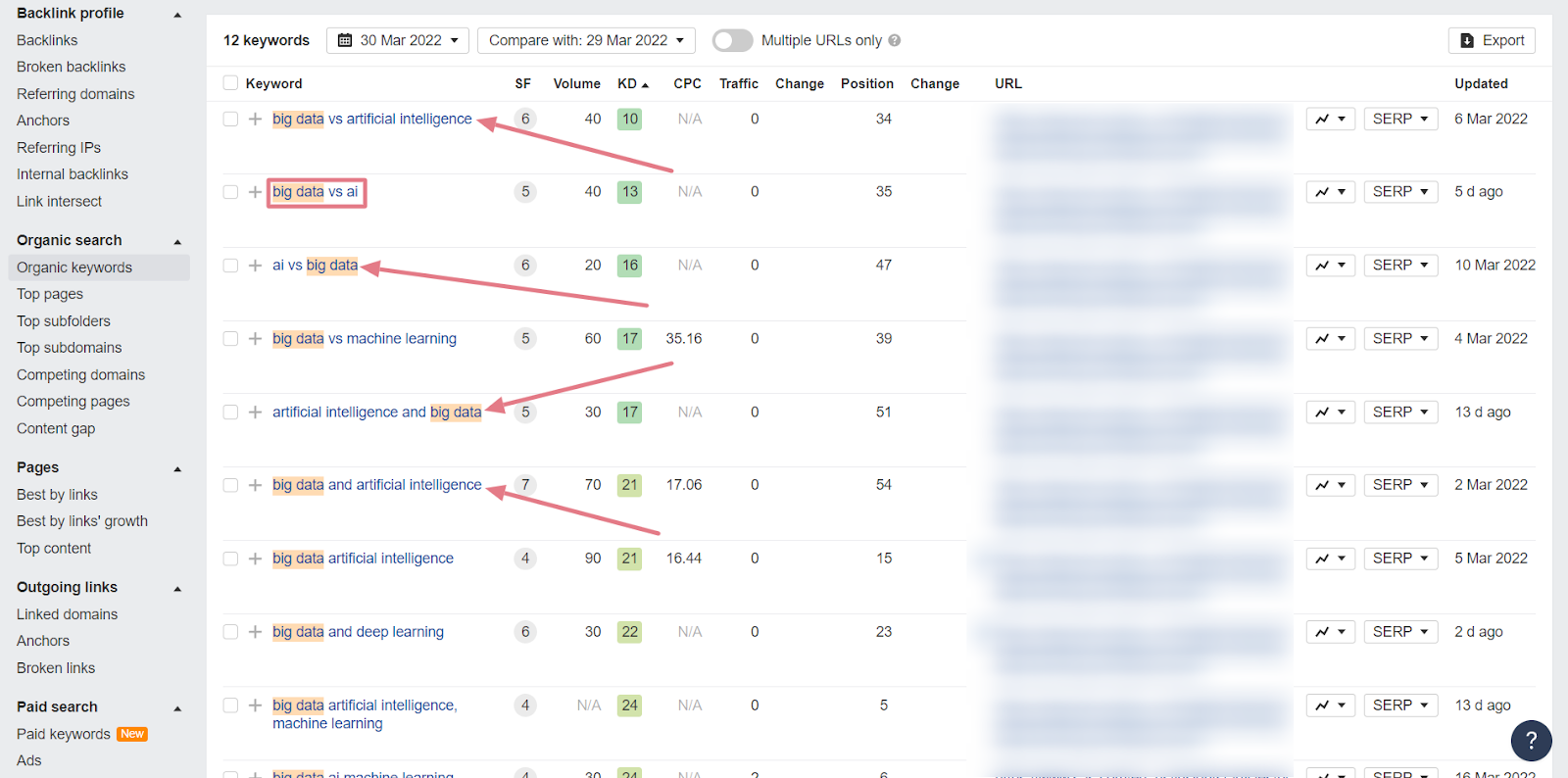
Here, you can see natural variations of the same target keyword you can use as anchor text.
In this case, you could:
- Use the exact keyword phrase, “big data vs AI”.
- Try a partial match, like “big data vs AI: what’s the big deal?”.
- Use long-tail forms of the target keyword, like “big data, artificial intelligence, machine learning”.
- Or natural variations, like “AI vs big data”, “big data vs artificial intelligence”, or “big data vs machine learning”.
They are all different and, for the best part, each search term has search volume.
By simply being versatile in your approach to anchors, you can make it easier for search engines to determine the relevance of your site to specific keywords, helping to rank your content for a multitude of keywords.
2. Stick to Natural Anchor Text
When building out your anchor text profile, be sure not to force things and definitely stay away from being spammy. In other words, don’t use tactics like keyword stuffing in your content with the idea that you can use these phrases to add a bunch of internal or external links to.
Google is way smarter than this.
It’ll soon sniff out any low-quality use of anchor text and hand out penalties as it sees fit.
You can see here an example of what should be avoided. Don’t use anchor text that uses the same phrase or keyword for the same or different linked page. Don’t stuff them together. And avoid generic phrases like “and so is this” – remember, give Google context.
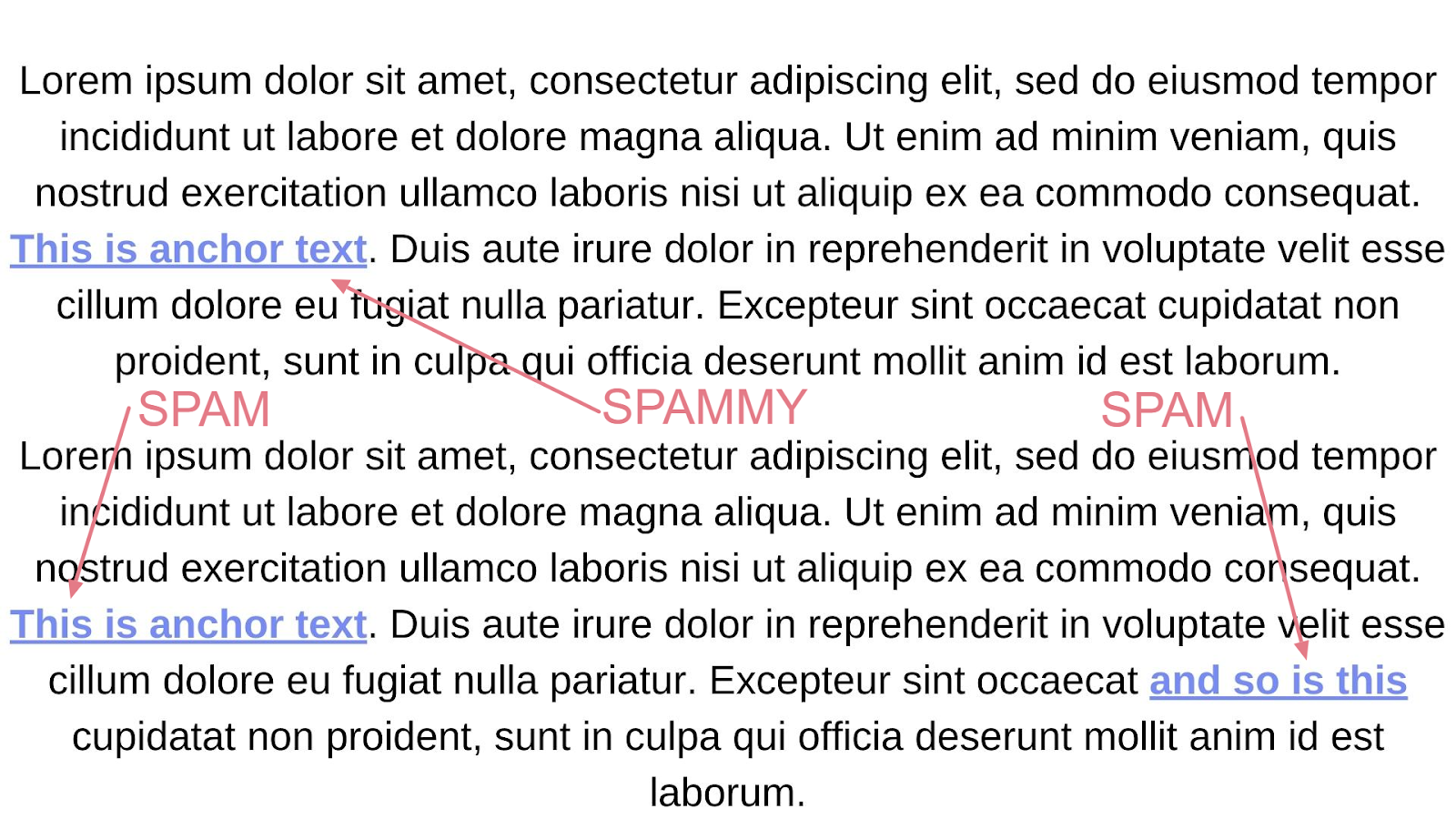
Instead:
- use natural language,
- distribute your hyperlinks and avoid stuffing anchor text,
- and add links only where it makes sense to both the reader and Google.
That way, you aren’t sacrificing user experience and are avoiding being targeted by a search engine’s disciplinary measures.
3. Understand That Surrounding Link Text Matters
The surrounding link text a backlink or internal link has been embedded between also matters. Google uses this surrounding text to gain a greater perspective on the relevance of a link. Specifically, Google Search Central guidelines (formerly Webmasters) states:
“Data surrounding the link, data to the left of the link or to the right of the link, or anchor text associated with the link may be used to determine the context associated with the link.”
You can see this here.
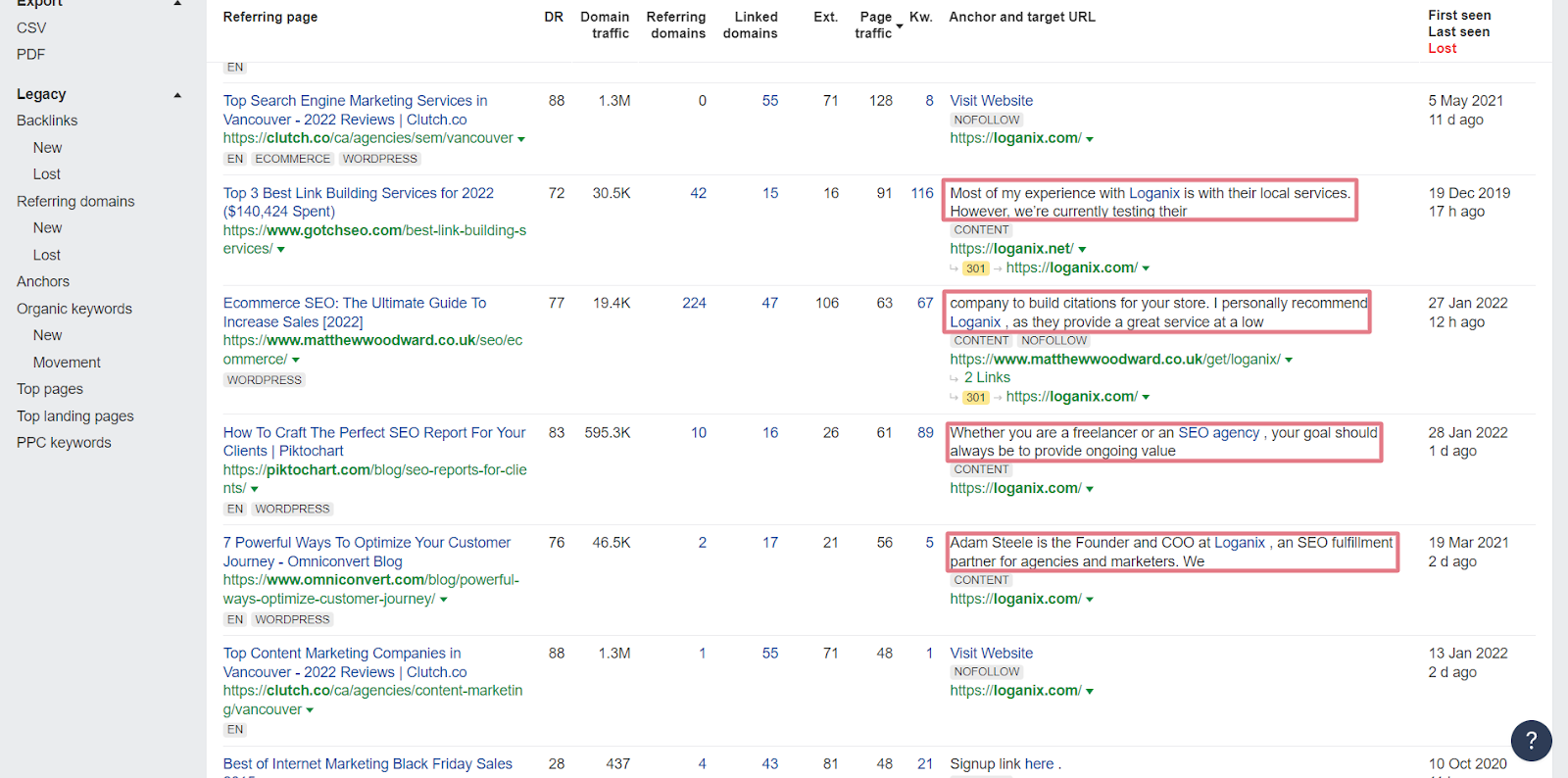
The SEO tool, Ahrefs, shows the surrounding text around backlinks that lead to our homepage. This gives us a glimpse into what Google’s algorithm may be paying attention to when discerning what our services are all about and when it’s appropriate to recommend them for certain search queries.
With this in mind, when adding internal links, don’t just whack them in willy-nilly. Instead, be sure to add them in a way that’s relevant to the surrounding text.
4. Avoid Over-Optimization
Although the correct use of anchor text, backlinks, and a well-set out internal linking structure are all important ranking factors, that’s not to say you should go over the top.
Google certainly isn’t a fan of over-optimization.
An anchor text that is used too frequently, is continuously exact match, or covers more than a single word or a phrase, may all be signals to Google that you are endeavoring to manipulate its algorithmic system.
Ideally, you’ll want to tailor your content for optimal anchor text ratios.
What’s optimal?

Using the SEO tool Moz’s analysis, ideally, a blend of:
- ~31% brand name,
- ~18% exact keyword match,
- ~18% naked URL,
- ~16.5% phrase match,
- and ~16.5% other or generic is best.
5. Prioritize Linking to Relevant Internal Content
When building your internal linking structure, it can seem intuitive to link to your homepage or best performing web pages at scale.
While this is helpful in small doses, pages that are over linked to or an anchor text profile that is skewed in one direction don’t look natural to Google and other search engines.
In fact, by making this mistake, you’re likely to affect the performance of your website.
Instead, as a general rule, you should be sharing the love, linking to pages within your website that are helpful in contextualizing the topic you’re focusing upon.
One of the best ways to do this is by building topic clusters.
Topic clusters are groups of related articles or subtopics that are clustered around a focus topic. Thinking through the lens of SaaS once again, your focus topic may be AI and your subtopics may include big data, machine learning, algorithmic patterns, etc.
In terms of SEO, there are many reasons clustering topics like this is a good idea. But for the context of anchor text, it’s an easy to follow method to building a solid internal linking structure and getting your anchor text just right.
6. Strategically Place Anchor Text
Not every user reads every word you or your writing team composes. Instead, many readers are simply looking for a certain portion of the content to answer their search query.
With this in mind, it’s a good idea to place anchor text and internal links at focal points or high-engagement areas. Of course, as we’ve discussed, don’t cram or overdo anchors. But be sure to place internal links where you think your website visitors will probably pay the most attention.
You can, of course, use your intuition here.
Or, better yet, you can employ the services of a heat map, like Hotjar.
Heat maps are a graphical representation of user interactions on a website. They show where users have clicked on the page and how much time they have spent on each area. This information can then be used to improve website design, usability, and where to place anchor text.
Summary
The use of correct anchor text is essential when optimizing your website for SEO purposes. Just remember to use a variety of anchor text phrases, as well as variations of your target keyword, to ensure that your site ranks as high as possible in search engine results pages.
To further bolster your SEO efforts, building a solid backlink profile that’s coupled with relevant, natural appearing anchor text is arguably one of the best ways to help improve your site’s SERP rankings and drive organic traffic to your site.
Here at Loganix, our link building services are the perfect blend of these two ranking factors. With help from our strict quality criteria and relationships with reputable, high-authority domains, we can help take your link building strategy and digital marketing efforts to a whole new level.
Hand off the toughest tasks in SEO, PPC, and content without compromising quality
Explore ServicesWritten by Aaron Haynes on April 23, 2022
CEO and partner at Loganix, I believe in taking what you do best and sharing it with the world in the most transparent and powerful way possible. If I am not running the business, I am neck deep in client SEO.





